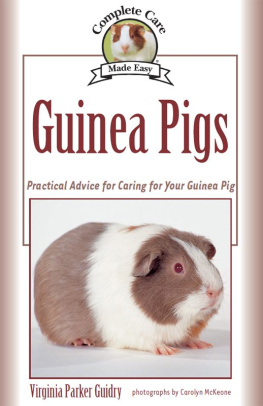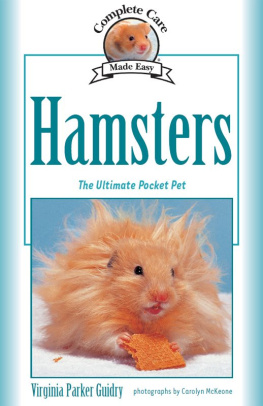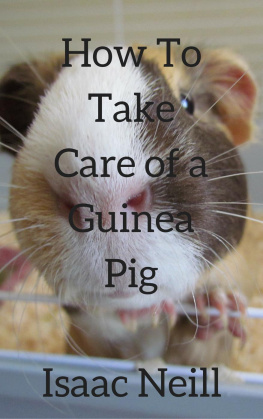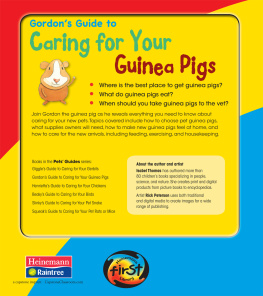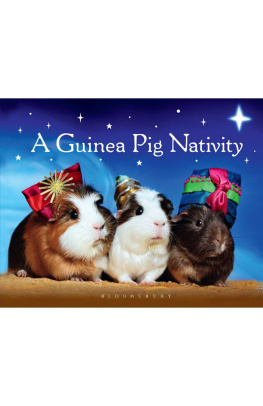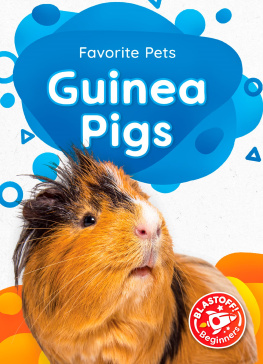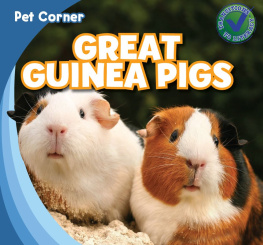

During the 1800s, guinea pigs became favorite pets of the ladies of the court.
W ELCOME TO THE WORLD OF GUINEA PIGS! Y OU CANT go wrong with a pet guinea pig. In fact, guinea pig enthusiasts swear the only way to live right is to share life with a guinea pig (or two or three ). Also known as cavies, these small, hairy critters who weigh a diminutive 2 to 3 pounds and measure 10 inches in length are fabulous pets. Theyre compact, easy to care for, and a bundle of fun. Guinea pigs are ideal pets because theyre clean and odorless. In addition, theyre gentle and loving companions with entertaining personalities no one can resist.
Cavies are great pets for anybody, adult or child, man or woman, boy or girl. Guinea pigs make excellent pets for families with children and are a favorite 4-H project animal. They are best kept indoors, but can be kept outdoors, can live in the city or country, and cost little to feed and care for. Perhaps best of all, with 13 breeds and a rainbow of coat colors and patterns to choose from, theres a guinea pig to suit everyones fancy.
Guinea pigs are considered fairly intelligent and frequently interact with their owners. They welcome loved ones with squeaks and whistles, especially at feeding time. Once accustomed to it, they enjoy being held and petted. They arent known for being escape artists and will usually remain safely tucked away in their cages. Biting isnt usually a problem either, though its always a good idea to keep fingers away from their mouths.
Feeding a guinea pig is simple; theres no mixing or fussing. A diet of quality alfalfa pellets for young, growing, and pregnant guinea pigs and timothy-based pellets for fully developed guinea pigs along with fresh veggies is sufficient to keep these little creatures healthy. Fresh water is essential, too. Guinea pigs live about five to seven years and usually remain quite healthy. Though hardy animals, they can be susceptible to some illnesses, so good care is imperative. Grooming is minimal and includes regular toenail trimming, some brushing, and attention to teeth.

Some guinea pigs are used as therapy animals and visit hospitalized children.
Guinea pigs are fun to watch, whether theyre eating, sleeping, grooming, or playing. They enjoy interacting with their own kind, so owners often hear their pigs talking to one another in squeals, coos, gurgles, or teeth clacking.
If all these positive points arent enough, guinea pigs are just plain cute. Their little faces are friendly and somewhat comical, and their stocky, round, and tailless bodies are extremely huggable.
Now hows that for a glowing introduction?
Wild Beginnings and History
Great modern day pets they are, but how did guinea pigswhich are neither pigs nor from Guinea in Africacome to be such wonderful and popular pets? Well, it certainly didnt happen overnight. As with many domestic companion animals, the process is a long one. For the domestic guinea pig, the story begins in ancient Peru.
Exact dates are impossible to know, but archaeologists contend that domestication of the guinea pig may have begun around 5000 B.C. in southern Peru and Bolivia. To the ancient peoples in these regions, cavies were important food sources and were also used in religious, ceremonial, and healing rituals. In some areas of South America today, people still use the wild guinea pig, called cuy, for food and as part of healing and religious ceremonies.
With the Spanish conquest of the Inca Empire, it is believed, cavies were brought from Peru to Europe during the 1500 or 1600s. Soon thereafter, guinea pigs became household pets. Queen Elizabeth I owned a guinea pig, as well as many European aristocrats. During the 1800s, guinea pigs became favorite pets of the ladies of the court and were carried about on silken pillows by servants. Guinea pigs were bred for specific traits, leading to the modern day plethora of breeds, colors, and coat patterns.

A guinea pig is flanked by two other popular pets: a chinchilla and a rabbit.
The domestic guinea pig eventually made its way to the U.S., where it became an instant hit among animal lovers. By the early 1900s, breeders were busy crossing and mating their guinea pig stock for the purpose of showing. The National Pet Stock Association was formed in 1910 to oversee the breeding of small mammals, including guinea pigs, rabbits, and hamsters. The organization narrowed its focus to rabbits and cavies in 1923 and changed its name to the American Rabbit and Cavy Breeders Association. In 1952 guinea pig fanciers decided to form a separate organization called the American Cavy Breeders Association. In response, the American Rabbit and Cavy Breeders Association changed its name, and intent, to the American Rabbit Breeders Association (ARBA). Later, the two separate clubs reunited, and today, the ARBA is the governing organization for both guinea pig and rabbit fanciers in the U.S.
The Name Game
THIS MUCH IS TRUE: DOMESTIC GUINEA PIGS ARE NOTpigs, nor are they from Guinea. Then how and why did these critters get tagged with the name guinea pig? Nobody knows for sure, but there are several ideas. Guinea could be a corruption of Guiana, which is in South America. Or, it might refer to Guinea in West Africa, where the creature could have passed through on its travels from one continent to another. And it might refer to a gold coin, no longer in circulation, called a guinea, which is said to have been the price paid for the guinea pig.
For those who know and love them, guinea pigs are also called pigs, oinkers, piggies, and wheekers. The sexes are referred to as sows and boars, just like pigs.
Fanciers today enjoy thirteen different breeds of the domestic guinea pig. But from the 1920s to 1970s, enthusiasts showed only three breeds: English (American), Abyssinian, and angora(Peruvian). The guinea pig fancy was limited to these three breeds until 1973, when a fourth, the white-crested, was accepted into the standard, followed by the numerous breeds enjoyed today.
Domesticated and Wild Guinea Pigs Today
The formal scientific name for the domestic guinea pig is Cavia porcellus. Biologists categorize the guinea pig like this: class Mammalia; order Rodentia; suborder Hystricognathi; family Caviidae; genus Cavia; species Cavia porcellus. Guinea pigs are considered by researchers as hystricognath rodents, a group that includes animals such as porcupines, chinchillas, and mole rats.
The Caviidae family, which consists of tailless rodents who have four digits on the front feet and three on the hind, consists of three genera and more than twenty species on the South American continent. In addition to guinea pigs, this family includes their wild cousins, including the Patagonian cavies (Dolichotis spp.) and rock cavies (Kerodon spp.). All species in the Caviidae family have been human food sources, but only the species in the genus Cavia is known to have been domesticated.
In South America, wild cavies live in burrows found in rocky areas, savannas, and forest edges from Colombia and Venezuela south to Brazil and Argentina. These wild cousins live in small colonies of about ten, foraging mostly at night for plants and mating throughout the year. Both wild and domestic guinea pigs are known for their ability to reproduce quickly. Typically, wild females give birth to at least two litters of three to four babies, called pups, each year. Wild guinea pig colonies usually have a dominant male and several females. One alpha female presides over the other females.
Next page
